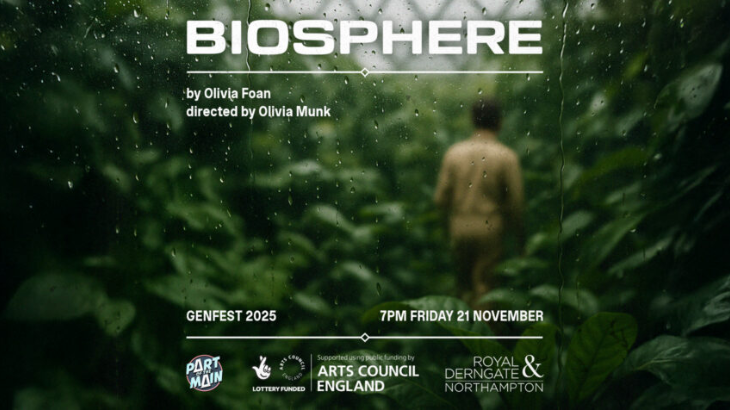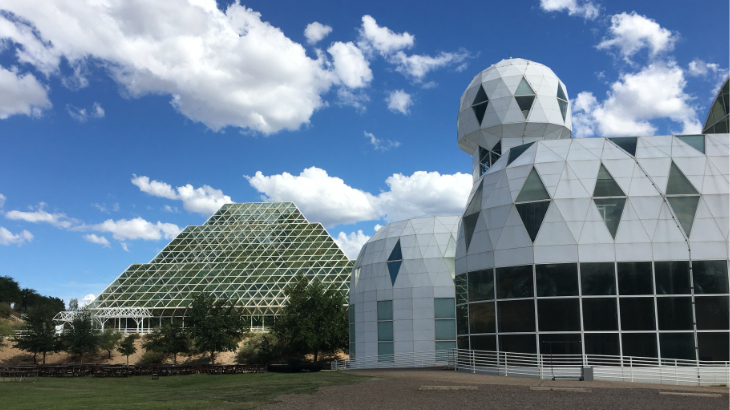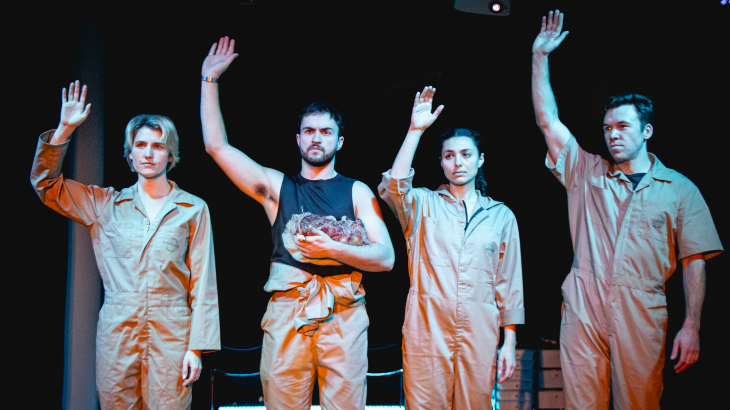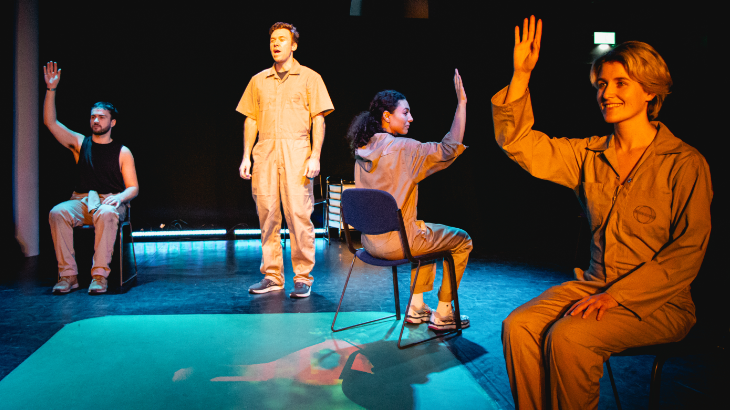BIOSPHERE: a drama

Theatre Director Olivia Munk1 invited CA-WN to the Royal & Derngate Theatre for the 21 November 2025 première of Olivia Foan’s2 drama BIOSPHERE. Many of us accepted and these are my personal observations.
The inspiration for the drama was a 1991 experiment in self-sufficient living called Biosphere 23. Playwright Olivia Foan dug deep into the experiment’s history and her research informed the play’s framework and its cast of characters.
BIOSPHERE: the background
Self-sufficient living was an important feature of the counterculture movements that flourished in 1960s America. Figureheads with charisma, knowledge and experience helped mould an entire generation’s cultural values, one in particular, Buckminster Fuller. He was a practical engineer who developed, amongst many other things, the geodesic dome. He was also a philosopher with a whole systems approach for making, in his words “the world work for 100% of humanity in the shortest time possible.”
Buckminster Fuller’s call for a global, cooperative approach to resource management and problem-solving resonated with one of his students who became the leader of a San Francisco collective, the Theatre of all possibilities4, a troupe of ultra-high energy individuals. Tiring of the hippy scene and seeking affordable pastures new they decamped to desertified land they’d acquired in New Mexico. Guided by the three principles that they saw as essential for the success of a holistic lifestyle - art, ecology, and enterprise - they built a large geodesic dome and set about transforming the land into an organic farm they called Synergia Ranch. There they established the Institute of Ecotechnics3 and launched enterprises that included a marine research vessel and their model of a more sustainable world that was to become Biosphere 2 – Biosphere 1 being planet earth.

It took five years and the wealth of a Texan billionaire to buy land in the aptly named district of Oracle, Arizona, on which to build an enormous ecological facility for the study and manipulation of mini biospheres. In accordance with their principles the experiment was conceived as a financial enterprise. To capitalise on the current excitement around space travel it was publicised as research into the maintenance of human life in an outer space colony. Such was the hoopla their publicity created that television news carried every detail as the eight Biospherians entered the facility for their two-year stay. However, a sceptical scientific community was unimpressed and questioned the validity of the entire commercialised experiment.
One Biospherian was let out for medical attention leading to allegations that essential supplies accompanied their return through the airlock. When CO2 levels rose to dangerous levels oxygen had to be pumped in. There were crop failures and food shortages, to the residents’ disgust only beetroot thrived. Life in the biosphere became increasingly difficult and inevitably tensions grew. All the while a paying public outside was witnessing everything. Though the eight survived their two-year stay the trivial events picked up by the media damaged the reputation and research credibility of the entire Biosphere 2 experiment.
BIOSPHERE: the drama
Olivia Foan’s four biospherians, a medic, a scientist and a farmer, are led by business titan Philip, their CEO who from the outset leaves the others in no doubt that he is their boss. Or is he?
Philip is constantly on the phone to mission controllers overseeing the experiment in which the four are locked up in their self-contained glass-walled world, all the while under the gaze of us, their sponsoring supporters. This raises the question if, like some artfully crafted reality TV show, commercial interests are dictating the actions of the four biospherians. It seems that way when Philip severs his finger in the shredding machine and is denied outside medical help lest it could break public trust in their experiment.

American Philip is an instantly recognisable big tech character wrapped up in his own importance yet constantly, insecurely, checking how he’s being seen by the outside world. He enters the biosphere with Rhea, the group’s doctor and his love interest. But Rhea’s ardour fades as instead she falls for the down-to-earth farmer Jack, constantly toiling in the biome garden. Miriam, the project scientist, exhibits her frustration without inhibition and leaves us wondering if her lust for bananas is more than a symptom of hunger for food. Miriam’s obvious availability fails to attract Jack who in due course wraps his arms around a happy to reciprocate Rhea. Philip is apparently oblivious to all these tensions that reflect the realities of cohabiting during months of isolation. In another nod to the realities of life, Jack’s plan to return to working at a community farm is interpreted as him joining a cult, seeding the thought that others may see things differently than us. Perhaps also a comment on the cult-like status afforded to charismatic leaders who attract an adoring and uncritical following?
There’s no doubt these four in their locked-in world are high energy. Olivia Munk’s direction makes that clear as Miriam’s scientific testing station and Rhea’s medical kit are briskly wheeled in and out whenever a scene changes within a performance space that’s surrounded on three sides by us voyeurs. We are gently engaged as biospherians regard us through their glass walls, though sometimes they are appalled by an audience member’s exhibitionism.

Jack’s garden comes and goes too. Sounds and lighting effects take us through the two-hour performance that includes marking the year’s experimental progression with birthday feasts laced with banana wine.
It isn’t just Philip's medical emergency that eventually sours the biosphere’s atmosphere. When oxygen levels fall Miriam gets blamed for miscalculating the rate that CO2 builds up in the biome. Crops fail and hunger sets in. Miriam creates angst by stealing a banana – cementing her fixation with bananas.
The drama wraps as the biospherians exit stage right, the last carefully closing the door behind them.
BIOSPHERE: the takeaway
The original Biosphere 2 experiment, and all that preceded it, provides a shocking reminder that climate disaster awareness, and the need for preparedness, reaches far back into the last century. Science-based warnings and mass demonstrations against government and public inaction have signally failed to put a spoke in the wheel of business-as-usual politics and commerce.
Today, surrounded as we are by climate change deniers, BIOSPHERE shows how drama can put the spotlight on a range of contemporary issues. Half a century ago, art, ecology, and enterprise were enjoined to fund, demonstrate and convey important messages about self-sufficiency and its prerequisites. Today society needs more Olivias Foan and Munk to bring truth-telling performances to the attention of the young of all ages.
BIOSPHERE: acknowledgments
The stars: Sam Landon as CEO Philip, Antonia Salib as Rhea the medic, Lauren O’Leary as Miriam the scientist and Eddie House as Jack the farmer.
Creatives & Consultants: Olivia Foan – Playwright, Olivia Munk – Director, Rachel Sampley - Lighting & Video Designer, Vyvyan Stewardson - Sound Designer, Christina Fulcher - Movement & Intimacy Director, Ophelia Fellhauer - Assistant Director, Gwenan Bain - Stage Manager, Jessica Bickel-Barlow - Audio Describer, Beth Lilly - Vocal Support. Dr Yusuf Osman - Audio Description Consultant, Dr Colleen Golja - Climate Science Consultant.
Funding: Arts Council
BIOSPHERE: special mentions:
The staff and volunteers at the Royal & Derngate whose friendly reception made the evening even more enjoyable.
The production was part of GenFest 2025, an initiative of the Royal & Derngate theatre's Generate Artist Development Programme focussed on connecting artists, audiences, and the local community.
The November 2025 week-long festival celebrated artist development and new work by showcasing emerging and established artists from Northamptonshire and the East Midlands.
The festival included performances in addition to BIOSPHERE, workshops, artist one-to-one advice sessions, and a chance for audiences to give feedback.
The Theatre Green Book4 which provides a shared language for living and working sustainably. Begun as a collective initiative by theatre-makers in the UK it has since grown to involve the performing arts industry across the world.
BIOSPHERE: postscript
Climate Science Consultant Dr Colleen Golja provided a reading list on Part of the Main, the production company’s website5. All Dr Golja’s book recommendations, except for the too provocatively named How To Blow Up A Pipeline by Andreas Malm, are now available to borrow from the CA-WN lending library.
BIOSPHERE: references
1 Olivia Munk
2 Olivia Foan
3 Institute of Ecotechnics
4 Theatre of all possibilities
5 Theatre Green Book
6 Part of the Main

